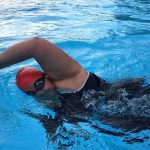
Swimming against the stream
The Selkie Henley Classic is a rare event. Not only does it start at 4:30 in the morning, you also have to swim against the current. Still, there must be something in it, as many people come back year after year.
Finishing times this year were slow. In 2019 (the last time this event was held as it was cancelled due to covid in 2020), the women’s winner, Vicky Cunningham, completed the 2.1km course in 29:34. This year, she won the women’s event again (and came third overall) in 31:32. Nearly 2 minutes slower.
There could be several reasons why Vicky swam slower: lack of training due to lockdown would be one reason. However, a quick glance at the other finishing times shows that the regulars were slower in 2021.
The most likely reason therefore is the difference in current. I took a quick look at the flow data for Maidenhead (the nearest measurement station) on the Environment Agency website. On event day 2019, the average flow was 16.5m3/s, but in 2021 it was 30.6m3/s.
The Thames at the event site is about 80m wide (measured on Google maps). If we assume an average depth of 1.5m we can estimate a current speed of about 0.14m/s in 2019 and 0.26m/s in 2021.
This might not sound like a lot, but a fast swimmer in the Henley Classic swims at around 1:20 per 100m, which is 1.25m/s. The effect of the current would be to reduce that swimmer’s pace to around 1:30 per 100m in 2019 and 1:40 per 100m in 2021. This would push their finishing time for the 2.1km from around 31:28 minutes to 35:10 – a difference of nearly 4 minutes.
The slower the swimmer, the more they will be impacted by the current. Someone who swims at around 2 minutes per 100m would lose about 10 minutes between 2019 and 2021. Vicky’s time suggests her pace in still water would be around 1:10 to 1:15 per 100m, which is why she lost relatively little.
These are only estimates but they show that swimming against even a benign current can make a huge difference to your overall time. If you struggled in the Henley Classic this year, now you know why.
This does raise the question: is there anything you can do to reduce the impact of the current?
Yes, you can.
In rivers, the current generally flows faster in the middle than at the edges. It is usually better to swim close to the bank when going upstream. At Henley, the booms prevent you getting too close to the bank, but I’d still swim as close as I could to the left boom (as you’re going upstream) as even a small difference in current will accumulate over the course of the race.
The Henley course is ruler-straight, so this doesn’t apply, but where the river bends, the current flows fastest around the outside, so stick to the inside if you can (this will also be the shortest route).
Then, if there are any obstacles in the water – moored boats, fallen trees, buoys etc. – it’s often worth sheltering behind them and only swimming out and around them at the last minute.
And take advantage of any drafting opportunities.
Finally, try to stay relaxed and don’t worry that you are moving more slowly than your effort suggests you should be. Watching the bank go slowly past is frustrating, but don’t be tempted to push harder too soon. Swimming against the current is equivalent to swimming additional distance, and you need more time to do that. Conserve your energy. Remember, the slower you swim, the more you are impacted by the current. If you start too fast, and then slow down, you will pay for it even more when swimming against the current than you would in still water. Pace yourself for the additional swim time.
What about swimming downstream?
If you like the idea of swimming at Henley but would prefer to swim with the current rather than against it, take a look at the Outdoor Swimmer Henley Swim Festival. With a range of distances, including the classic mile, there’s something for everyone. And prepare for a fast time as the current sweeps you down river.
Find out more: https://henleyswim.com/events/henley-swim-festival/









